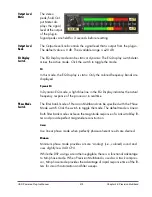
UAD Powered Plug-Ins Manual
- 459 -
Chapter 45: Precision Maximizer
Operating Tips
• As a starting point for general loudness enhancement, set Precision Maxi-
mizer to one-band mode with Limit engaged, with Mix at 100% and Shape
at 50%. Then set Input so signals peak at around 0 dB on the Input Meters.
These settings offer good results under most conditions, producing more
presence with a warmer sound and enhanced detail (especially with lower
frequencies), while retaining the apparent dynamic range of the original
signal.
• The most natural warmth and tube-style distortion can be obtained with
Shape at 50% in one-band mode, with Limit off, and signal peaks just touch-
ing 0 dB at the input. Shape at 50% delivers the lowest amount of higher or-
der harmonics and most closely emulates a tube characteristic.
• More overdrive may be obtained by disengaging the Limit function. Up to
+6 dB of additional headroom is available before clipping occurs when
Limit is off. This can cause clipping at the output, so reduce the Input and/or
Output control to compensate if necessary.
• Input clipping can dramatically change the distortion characteristic, and
may yield significantly different results in one-band versus three-band mode.
• Generally speaking, the input should be set as high as possible before un-
desirable sound quality is obtained.
• For optimum results (especially when Limit is off) ensure the source signal is
not clipped before it arrives at the Precision Maximizer input.
• Output clipping can be completely avoided by enabling Limit.
• One-band mode is generally recommended for program material.
• Set Mix at 100% in order to hear the full affect of the Maximizer process.
Reduce Mix when blending in the original signal is desired.
• Changing the order of plug-ins in the signal path can have a dramatic affect
on Precision Maximizer results.
• Sonic experimentation is highly encouraged!
Precision Maximizer Latency
The Precision Maximizer uses an internal upsampling technique to facilitate
its amazing sonic quality. This upsampling results in a slightly larger latency
than other UAD plug-ins. See
“Compensating Upsampled Plug-Ins” on
page 108
for more information.
















































